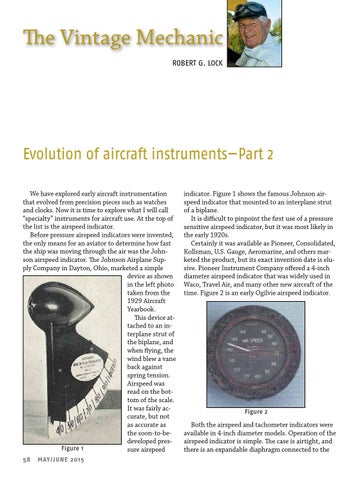The Vintage Mechanic ROBERT G. LOCK
Evolution of aircraft instruments—Part 2 We have explored early aircraft instrumentation that evolved from precision pieces such as watches and clocks. Now it is time to explore what I will call “specialty” instruments for aircraft use. At the top of the list is the airspeed indicator. Before pressure airspeed indicators were invented, the only means for an aviator to determine how fast the ship was moving through the air was the Johnson airspeed indicator. The Johnson Airplane Supply Company in Dayton, Ohio, marketed a simple device as shown in the left photo taken from the 1929 Aircraft Yearbook. This device attached to an interplane strut of the biplane, and when flying, the wind blew a vane back against spring tension. Airspeed was read on the bottom of the scale. It was fairly accurate, but not as accurate as the soon-to-bedeveloped presFigure 1 sure airspeed 58
MAY/JUNE 2015
indicator. Figure 1 shows the famous Johnson airspeed indicator that mounted to an interplane strut of a biplane. It is difficult to pinpoint the first use of a pressure sensitive airspeed indicator, but it was most likely in the early 1920s. Certainly it was available as Pioneer, Consolidated, Kollsman, U.S. Gauge, Aeromarine, and others marketed the product, but its exact invention date is elusive. Pioneer Instrument Company offered a 4-inch diameter airspeed indicator that was widely used in Waco, Travel Air, and many other new aircraft of the time. Figure 2 is an early Ogilvie airspeed indicator.
Figure 2
Both the airspeed and tachometer indicators were available in 4-inch diameter models. Operation of the airspeed indicator is simple. The case is airtight, and there is an expandable diaphragm connected to the
